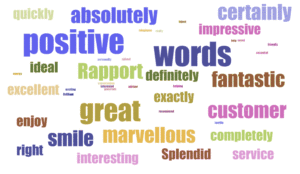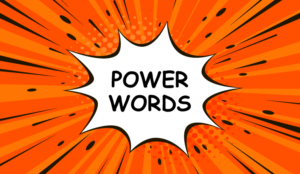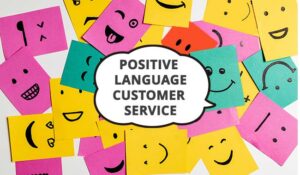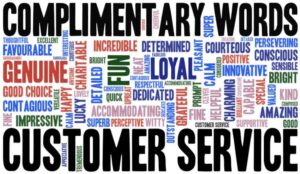It’s tempting to create a list of banned words and phrases for your contact centre advisors – but doing so can do more harm than good.
Harsh rules don’t help your team become better communicators; they just stop them from thinking critically. Instead, advisors need context, coaching, and alternatives that make sense in real customer conversations.
In this article, we explore how to move beyond “never say this” lists with examples for replacing negative words with positive words.
10 Examples of Negative vs Positive Phrases
Instead of “scolding” advisors for using certain words and phrases, you need to coach better alternatives. We give you five negative phrases that are commonly used and more positive words to use instead.
So, without further ado, here’s the list of phrases, alongside some suitable replacements.
| NEGATIVE WORDS | POSITIVE WORDS |
|---|---|
| “We regret any inconvenience this may have caused” | “I’m sorry that your experience was…[reflect the customer’s language – so long as it wasn’t rude!]” |
| “Our records indicate…” | “I have reviewed your online account and I see that…” |
| “Please do not hesitate to contact us” | “Please contact us if you have any questions about your… . We’re happy to help.” |
| “Your feedback will be shared with the appropriate department” | “I will share your feedback about… with our [insert name of relevant department].” |
| “Please do not reply to this message as the mailbox is not monitored” | “For questions about… contact: xxx.blah.com or call: 01234 567 890.” |
| “I’m sorry that you’ve felt the need to complain” | “I’m sorry, I can appreciate how [insert problem] must have been frustrating you” |
| “You may find it quicker to get the answer you need from our website at blah.com” | “Let me direct you to the page on the website that gives you the information/let me ping you a link to the information” |
| “I don’t know” | “To find out, what I’m going to do it…” |
| “Is there anything else that I can help you with? (When the customer hasn’t had their original query resolved” | “I’m sorry that you’ve had to contact us. I will raise the issue with the [insert] team to ensure that this doesn’t happen again in the future.” |
| “It’s our policy. There’s nothing else I can do…” | “What I can do for you is…” |
| “I don’t need to pass this chat to a manager. I can help you!” | “Can you tell me a little more about it please?” |
1. “We Regret Any Inconvenience This May Have Caused”
It’s better to say – “I’m sorry that your experience was… (insert the word that the customer used to explain their experience – so long as it isn’t really rude!)”
The use of the words “may” and “any” can sound passive-aggressive; it’s as if you’re casting doubt on the fact that there was a problem in the first place.
Also, we need to coach advisors to use alternatives to the word “inconvenience”, so that it’s not used as a “blanket term”. It is perfectly acceptable to use the word “inconvenience” for something that was supposed to be convenient but just didn’t turn out that way.
For example, if a simple transaction takes a bit longer to complete than it should have taken – but everything ends well – that is inconvenient.
However, in most cases, there are many other words that can be used to describe the customer’s poor experience. So the training goal is to help advisors to find other words to replace the word “inconvenience”.
You cannot respond to a customer email or letter in which they express a great deal of worry and emotion, with “I’m sorry for the inconvenience.” That’s awful!
2. “Our Records Indicate…”
It’s better to say – “I have reviewed your online account and I see that…” / “I’ve pulled up the invoice that you’ve asked me about and I can tell that…”
If the customer has previously said: “My records show…”, it would be perfectly acceptable to say: “Our records show something different.”
However, by using this as a generic phrase, we are missing a key opportunity to demonstrate that we have just taken action on the customer’s behalf.
So, it’s better to use first person and active verbs in these scenarios, because it helps to reassure the customer that you, as the advisor, are looking at current information.
By making this indication, you ensure that the customer becomes aware they are not receiving generic advice, instead you are giving them advice based on what you know about their purchase records, current account, etc.
Also, by using active language, you can better build rapport with the customer, as they can sense that you are actively helping them.
3. “Please Do Not Hesitate to Contact Us”
It’s better to say – “Please contact us if you have any questions about your… . We’re happy to help.”
This phrase is a mindless courtesy that trips off the tongue easily, which means that we need to be careful when coaching advisors to avoid writing it down.
Why do we have to be especially careful with this phrase? Because mindless courtesies can result in discourtesy.
Few customers actually hesitate before writing to an organization’s customer service team, so to keep our language authentic, let’s teach advisors to replace this worn-out phrase with a carefully considered courtesy phrase.
4. “Your Feedback Will Be Shared With the Appropriate Department”
It’s better to say – “I will share your feedback about… with our… [insert name of relevant department].”
When you use this phrase, the subtext is clear: you’re going to ignore the feedback.
So, why are so many contact centres still using statements like this? Because we often fail to solve the problem for the customer and we cannot change the past.
In these situations, all we can really do is tell the customer “what you’re complaining about really matters to us and we will share the matter with the department within our company that can do something about it.”
Yet this wording still sounds false. So you must use specific language instead. To do this, you firstly need to ensure that you name the department that you are going to share the customer’s feedback with, i.e. “I will share your feedback about the breakfast you were served on the plane with our catering team.”
5. “Please Do Not Reply to this Message As the Mailbox is Not Monitored”
It’s better to say – “For questions about… contact: xxx@blah.com or call: 01234 567 890. (Note: please do not reply to this email).”
This phrase and others that imply the same thing – i.e. “please do not reply directly to this email” – are examples of inadequate customer service.
Don’t announce to customers what they shouldn’t do. This practice may serve the company to some extent, but it is not good from a customer’s perspective. A customer wants to know: what should I do?
So, if you’re sending an email from a “do not reply” email address and it’s an order confirmation that has been automated, for example, you need to at least say:
“For questions about this order, reply to xxx@blah.com.” After putting the email address that you want customers to use, you can then write: “Please do not reply to this message…”
Just make sure that you have told the customer what to do before you tell them what not to do. After all, you want customers to feel as though helping them to answer their questions is more important than the ease of your operation.
If your contact centre uses scripts and you wish to replace any of the phrases, you may find some more helpful advice in our article: Positive Scripting for Customer Service
Each of these phrases is irritating in its own way, but they all share the following traits, which are key reasons why customers dislike them:
- They aren’t specific and thus aren’t believable
- They sound insincere or hackneyed
- They fail to give CSRs credit for having taken action
- They do a poor job of explaining to the customer what to do next
- They are corny
6. “I’m Sorry That You’ve Felt the Need to Complain”
It’s better to say – “I’m sorry, I can appreciate how [INSERT PROBLEM] must have been frustrating for you.”
“Felt the need to complain” – yuck! This is extremely passive-aggressive and it implies the customer was wrong to make the complaint in the first place. It’s hardly a statement designed to make the customer feel better…
7. “You May Find it Quicker to Get the Answer You Need on Our Website at Blah.com”
It’s better to say – “Let me direct you to a page on our website that gives you the information.” / “Let me ping you a link with all the necessary information.”
It’s the 21st century. It is most likely that the customer has found your website and, if it had been useful, they wouldn’t have needed to write to you.
8. “I Don’t Know”
It’s better to say – “To find out, what I’m going to do is…”
This reflects badly on the company, as it implies that you, as the advisor, have received improper training. Instead, you need to highlight what you have done or are doing to solve the customer’s query.
9. “Is There Anything Else I Can Help You With?” (When the Customer Hasn’t Had Their Original Query Resolved)
It’s better to say – “I’m sorry that you’ve had to contact us. I will raise the issue with the… team, to ensure that this doesn’t happen again in the future.”
The customer is already disappointed, so don’t fan the flames by asking this question. Find another way to give a courteous goodbye, which will most likely be with a sincere apology…
10. “It’s Our Policy. There’s Nothing Else I Can Do…”
It’s better to say – “What I can do for you is…”
By using this phrase, you sound like you are looking for a way to end the interaction. We need to focus on what we can do for the customer and not what we can’t.
11. “I Don’t Need to Pass This Chat to a Manager. I Can Help You!”
It’s better to say – “Can you tell me a little more about it, please?”
The customer is likely stressed if they wish to speak to a manager right away, so you need to first show empathy and ask probing questions to get to the bottom of the issue yourself.
12. “Feel Free to Contact Us Again”
It’s better to say – “Please contact us if you have any questions about your… . We’re happy to help.”
This phrase causes customer frustration in the same way as “Please do not hesitate to contact us” – it’s a mindless courtesy that is just far too corny and inauthentic.
A Quick Warning – Don’t Ban Certain Words and Phrases
Don’t take the hard-line ‘I told you never to write or say that’ approach and ban certain words and phrases, as you are not helping advisors to become better writers.
While there is a big appetite for this type of ‘never write that’ scolding, the people who get scolded – frontline customer service writers – will just accept it, as opposed to learning from it.
Leslie O’Flahavan, Founder of E-Write, says: “If you tell your customer service team to never use a phrase like ‘no problem’, that’s not solid advice.”
“We say don’t use the term ..’no problem’ because it is too colloquial, and it implies that there was a problem to begin with, but there are cases where it is acceptable to reply with ‘no problem’.”
“For example, a customer could end a sentence by saying: ‘Is that a problem?’, for which it is only natural to respond by saying ‘no problem’.”
So, make sure you take context into consideration and coach advisors so the “banned” words and phrases in this article are omitted from your email, chat and social media responses to customers.
Remember to Coach Advisors on Better Alternatives
Finally, before we get into some reader examples of words and phrases to avoid, we need to recognize the importance of coaching advisors.
When we tell advisors off for using certain phrases, they just stop thinking. We don’t want that! So we need to coach them to use better alternatives and explain why.
Good writing, after all, comes from making choices. So, we need to coach our advisors to understand all of the options that are available to them and apply these options to the relevant query types.
If not, your customer service will suffer and if you decide to just ban words, your handling times will increase as well – as one Scottish contact centre found out the hard way.
This contact centre had a list of banned words, which included negative words like “unfortunately”, but they discovered that you sometimes needed these “mitigating words” to hold a fluent conversation.
The result was that advisors were having to think on their feet, trying to find ways to avoid saying the obvious, creating disjointed conversations and driving up AHT.
So, when you coach advisors not to use certain words and phrases, make sure they are fully aware of all of the alternatives that will help the conversation to flow.
To find out more about the contact centre which unsuccessfully banned words, read our article: Why Removing Negative Words Could Hurt Your Contact Centre
Avoid Transition Words Where Possible
Let’s move on to to the good stuff! And the first set of words that you should be wary of using in your customer service writing are transition words.
These are words designed to link one sentence to another, and examples include however, therefore and furthermore. But why can it be best practice to avoid such transition words?
Leslie says: “In school we were taught to knit our writing together with transition words, but this careful knitting doesn’t match how people read customer service chats, emails and letters.
Customers scan the responses they receive from your contact centre, especially people who are urgently awaiting an answer to their query. They don’t read these responses thoroughly, word-for-word.”
The alternative that Leslie puts forward is use “scannable” headings and subtitles within the chat, email or letter, so the content is easier to follow and read.
Another couple of tips to improve your customer service writing is to use bullet points when articulating a “step-by-step” process and to stick to one idea per sentence, where possible.
Find out more great customer service language advice from Leslie in our article: Making Your Customer Service Writing Simple, Friendly and Personal
For more on coaching advisors to have better conversations, read our articles:
- Customer Service: 50 Nice Words to Say to Someone
- 15 Things a Call Centre Agent Should Never Say (But Many Do)
- Positive Customer Service Language for Positive Conversations
Author: Charlie Mitchell
Reviewed by: Hannah Swankie
Published On: 10th Jul 2019 - Last modified: 4th Apr 2025
Read more about - Skills, Customer Service, Editor's Picks, Email, Handling Customers, Language, Leslie O'Flahavan, Live Chat, Rapport




















